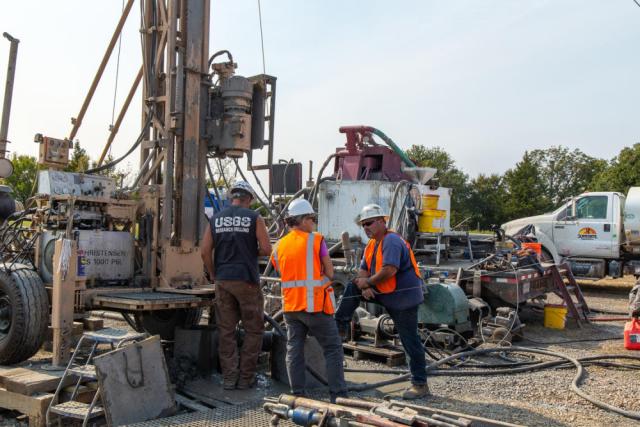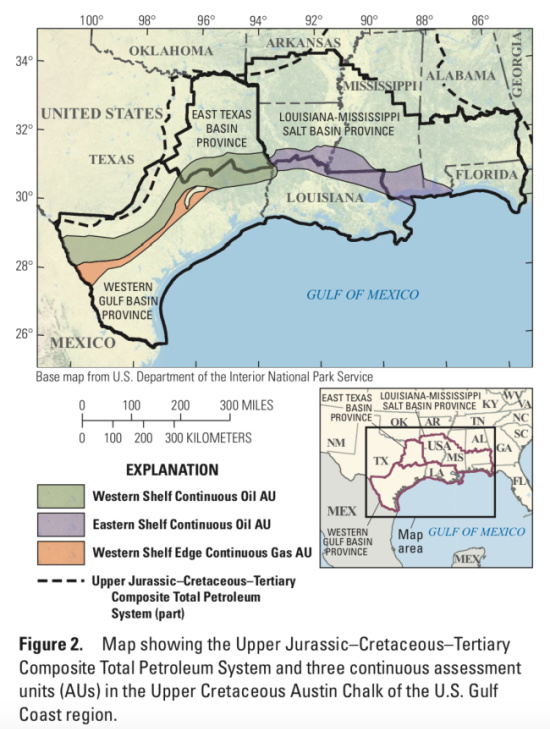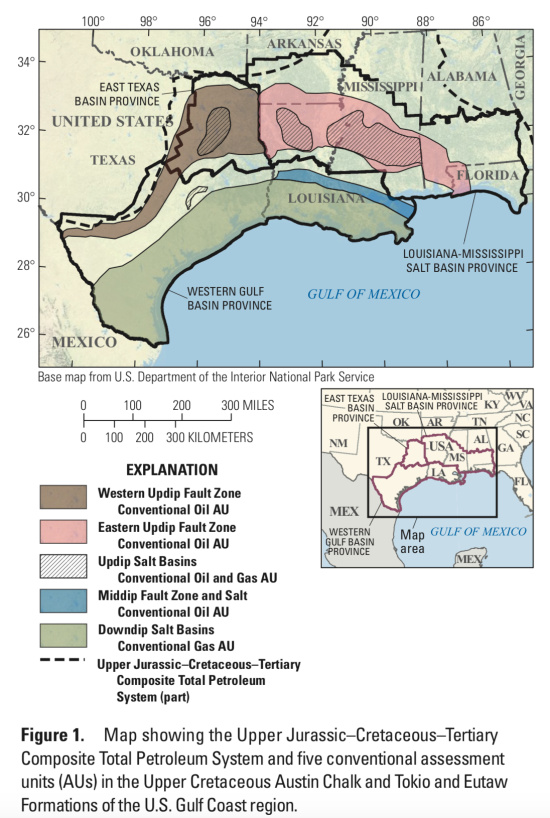
U.S. Geological Survey technicians at the USGS Gulf Coast #4 Bonham borehole prepare for geophysical logging of the Austin Chalk Group and the Eagle Ford Group mudstones in Fannin County, Texas. (Source: Stan Paxton/USGS)
Backed by advances in technology, continued drilling and a better understanding of geology and petroleum system characteristics, a newly released report shows the Austin Chalk, Tokio and Eutaw formations could hold about 6.9 billion barrels of oil and 41.5 trillion cubic feet of natural gas in undiscovered technically recoverable resources.
The updated assessment, focusing on the Upper Cretaceous geologic formation of the Gulf Coast Basin onshore and in state waters, was released Oct. 29 by the U.S. Geological Survey (USGS). It comes about a decade after the last assessment revealed the area had an estimated 957 MMbbl of undiscovered oil and 3.6 Tcf of gas.
The Austin Chalk has a long and storied history. While some companies have had success in parts of the play, others have struggled—battling massive amounts of water from fractures—in other areas.
RELATED
East Texas Chalk: It’s The Matrix
E&P Momentum: Austin Chalk Redux
Most of the resources are located in Texas, where companies such as EOG Resources Inc., Magnolia Oil & Gas Corp. and SM Energy Co. are among the players. The hydrocarbons are mainly sourced from “immediately underlying, thermally mature mudstone in the Upper Cretaceous (Cenomanian–Turonian) Eagle Ford Group,” according to the report.
“Texas is the state that just keeps on giving when it comes to oil and gas,” USGS Director Jim Reilly said in a statement. “Our assessment shows what can be accomplished through advances in technology by industry and the hard work our scientists put in to understanding the geology of petroleum systems in Texas.”
As part of the assessment, the USGS focused on eight assessment units (AUs)—five conventional and three continuous, which is defined by the USGS as oil and gas resources that are spread throughout a geologic formation and require special recovery methods such as horizontal drilling and hydraulic fracturing.
Of the continuous AUs, most of the undiscovered technically recoverable oil resources are on the Western Shelf—with estimates at nearly 6.6 Bbbl. The area extends west across the Maverick Basin to the Texas border with Mexico, according to the report. Most of the natural gas and NGL resources are located on the Western Shelf Edge with mean estimated undiscovered resources of about 26,142 Bcf of gas and 1,044 MMbbl of NGL.

Of the conventional oil and gas AUs, undiscovered oil resources were highest in the Updip Salt Basin, where the USGS report showed a mean of 10 MMbbl. Results also pointed to 17 Bcf of gas in each the Updip Salt Basin and Downdip Salt Basin AUs with the latter having the most NGL undiscovered resources at 9 MMbbl.

The area covered in the assessment spans from the Texas-Mexico border and arches across parts of Arkansas, Louisiana, Mississippi and into Alabama coastal area. “The Austin Chalk transitions into sandstone and mudstone of the Tokio Formation in Arkansas and Louisiana and the Eutaw Formation in Mississippi and Alabama,” according to the USGS.
Though the USGS said it believes the undiscovered resources highlighted in the assessment can be produced with existing technology and industry practices, “whether or not it is profitable to produce these resources has not been evaluated by the USGS.”
Recommended Reading
Rhino Taps Halliburton for Namibia Well Work
2024-04-24 - Halliburton’s deepwater integrated multi-well construction contract for a block in the Orange Basin starts later this year.
Halliburton’s Low-key M&A Strategy Remains Unchanged
2024-04-23 - Halliburton CEO Jeff Miller says expected organic growth generates more shareholder value than following consolidation trends, such as chief rival SLB’s plans to buy ChampionX.
Deepwater Roundup 2024: Americas
2024-04-23 - The final part of Hart Energy E&P’s Deepwater Roundup focuses on projects coming online in the Americas from 2023 until the end of the decade.
Ohio Utica’s Ascent Resources Credit Rep Rises on Production, Cash Flow
2024-04-23 - Ascent Resources received a positive outlook from Fitch Ratings as the company has grown into Ohio’s No. 1 gas and No. 2 Utica oil producer, according to state data.
E&P Highlights: April 22, 2024
2024-04-22 - Here’s a roundup of the latest E&P headlines, including a standardization MoU and new contract awards.






